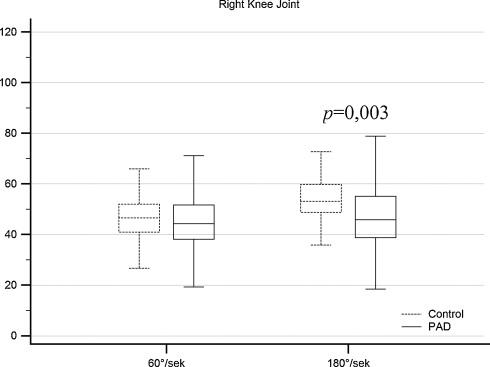Peripheral arterial disease decreases muscle torque and functional walking capacity in elderly |
| |
| Affiliation: | 1. University of Physical Education in Wroclaw, Department of Physiotherapy and Occupational Therapy in Conservative and Interventional Medicine, al. I. J. Paderewskiego 35, 51-612 Wroclaw, Poland;2. WROVASC—An Integrated Cardiovascular Centre, Specialist District Hospital in Wroclaw, Centre for Research and Development, ul. H. Kamieńskiego 73a, 51-124 Wroclaw, Poland;3. University of Physical Education in Wroclaw, Department of Physiotherapy and Occupational Therapy in Locomotor Dysfunction, al. I. J. Paderewskiego 35, 51-612 Wroclaw, Poland;4. 4th Military Clinical Hospital with a Polyclinic in Wroclaw, Department of Internal Medicine, ul. Rudolfa Weigla 5, 50-981 Wroclaw, Poland;5. Medical University of Wroclaw, Department of Pathophysiology, ul. Marcinkowskiego 1, 50-368 Wroclaw, Poland;6. Wroclaw University Hospital, Departament of Internal Medicine, Occupational Diseases and Hypertension, ul. Borowska 213, 50-556 Wroclaw, Poland;7. Specialist District Hospital in Wroclaw, Department of Angiology, ul. H. M. Kamieńskiego 73a, 51-124 Wroclaw, Poland |
| |
| Abstract: | 
ObjectivesThe aim of this study is to compare values of force–velocity and functional walking capacity in elderly patients with intermittent claudication with respect to the control group.Materials and methodsThe study involved 135 individuals: 85-peripheral arterial disease (PAD) group diagnosed with stage II chronic lower limb ischemia, according to Fontaine's classification, and 50-control group. The studies included an assessment of walking capacity using a six-minute walk test (6MWT) and measurement of force–velocity parameters (peak torque—PTQ, total work—TW, average power—AVGP) of the lower limbs obtained by means of a functional dynamometry under isokinetic conditions.ResultsThe peripheral arterial disease group is characterized by significantly lower values of force–velocity parameters compared to the control group (p < 0.005). Walking capacity in this group is significantly reduced due to significant differences in the distance covered (p < 0.0001), walking speed (p < 0.01), and its intensity (p < 0.01). Further, a positive correlation was found between the maximum distance specified in the six-minute walk test and lower limb muscle strength in the isokinetic test.ConclusionsMean values of all force–velocity parameters and walk distance were significantly higher in the control group than in the peripheral arterial disease group. In the PAD group, in both men and women, the value of the agonist/antagonist ratio of both lower limbs are lower in men and women comparing to the control group. A rehabilitation program for patients with intermittent claudication must consider exercises improving strength, exercise capacity, and endurance in patients with PAD. |
| |
| Keywords: | Peripheral arterial disease (PAD) Six-minute walk test (6MWT) Muscle torque Isokinetic Walking capacity |
| 本文献已被 ScienceDirect 等数据库收录! |
|

